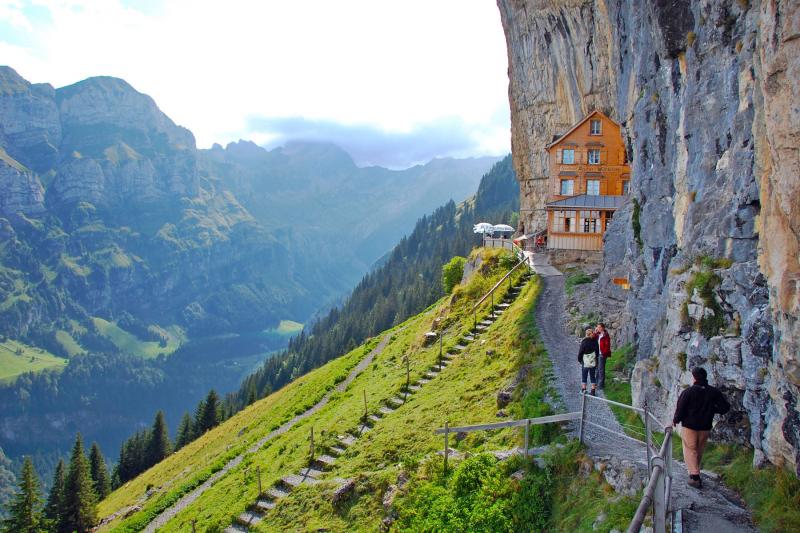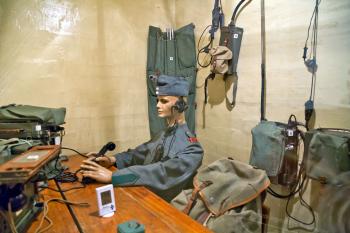Off the beaten track in Switzerland
Appears in the Online Edition, October 2018.
Mountainous Switzerland is well-known for its cows, chocolate, and stunning scenery -- but there's more to enjoy. Here are some lesser-known Swiss travel treats.
Experience Swiss military readiness. To protect its prized neutrality in the tumultuous 20th century, Switzerland wired its roads, bridges, and tunnels so they could be destroyed with the push of a button. They tried to make the whole country an impenetrable mountain fortress. Most of these military installations -- big guns in barns, air strips hiding like the Batmobile, and even hospitals buried deep in the mountains -- are now tourist attractions, such as Fortress Fürigen near Lucerne.
Go topless on an alpine train. While Switzerland has many impressive train trips and fancy "panoramic" cars, the most thrilling ride is in an open-top car. You'll be awestruck both at Switzerland's alpine wonders and its ability to tame nature with its railroad engineering. These topless or skylight-equipped trains run only in summer, and in just a few spots (such as along stretches of the Bernina Express route, stretches of the Glacier Express route, and up the Brienz Rothorn excursion route that climbs from the shores of the Berner Oberland's Lake Brienz).
Walk a ridge. One of Switzerland's most glorious hikes is the walk along the ridge called Schynige Platte to the cable-car station high above Interlaken in the mountainous Berner Oberland region. You're virtually tightrope-walking along a skinny ridge for several hours. On one side are lakes; on the other is a mountain panorama of dramatic cut-glass peaks. And ahead, you may hear the long legato tones of an alphorn announcing that a helicopter-stocked mountain hut is open ... and the coffee schnapps is on.
Get the big-city perspective. Zürich affords a peek at Swiss solutions to persistent urban problems. As you stroll down the main drag, you'll see designer boulders breaking through the sidewalk. These aren't decorative; they're there to stop the cars of thieves from crashing into jewelry stores for a grab-and-run. Around the corner, public toilets have blue lights. This prevents junkies from shooting up there: Under blue wavelengths, they can't see their veins.
Walk the path of a hermit monk. A century ago, a hermit monk inhabited a humble church in a cave just under a mountaintop plateau called Ebenalp, high above the town of Appenzell. A cliff-hugging path leads around the corner to the humble guesthouse that was built -- right into the vertical cliff side -- to accommodate pilgrims who had hiked up to pray with the monk. While the guesthouse isn't currently accepting overnight stays, and its restaurant is undergoing renovations that may close it for a while, the hut's setting is impressive enough to merit the excursion.
Ride a high-mountain summer luge. Ascending Mount Pilatus, near Luzern, is worth it for the heavenly views alone. But for extra thrills, hit the summer-fun zone of Fräkmüntegg, an area on the mountain's north slope. Here you'll find Switzerland's longest summer luge ride. Sit yourself in a sled-like go-cart, grab the joystick brake, then scream back down the mountainside on a banked stainless-steel course. Then take the lift back up and start all over again. Nearby is a park with 10 fun ropes courses and plenty of options for novices.
Ponder some insane art. Lausanne's Collection de l'Art Brut is unique in Europe. In 1945, artist Jean Dubuffet began collecting art he called brut -- untrained, ignoring rules, highly original, produced by people free from artistic culture and fashion trends living in psychiatric hospitals and prisons. Visiting his collection, you'll wander through halls of fascinating doodles and screaming colors, marveling at the talent of people our society has locked up as "criminally insane."
Relive the Swiss old days. At the Ballenberg Open-Air Folk Museum (an hour east of Interlaken on Lake Brienz), traditional houses, schools, churches, and shops from all over Switzerland have been moved to a huge park. The layout is just like the country: French in the west, Italian in the south, and so on. Each dwelling is furnished, old-time crafts are kept alive, and goat herders are tooting their slender stretch alphorns. It's Swiss culture on a lazy Susan for the hurried visitor, and a great rainy-day option in the Berner Oberland.
Climb the Eiger ... the easy way. You don't need to be a rugged mountaineer to climb the ultimate alpine cliff face -- you just need train fare. For a century, a thrilling train has tunneled up through the inside of the Berner Oberland's Eiger mountain. Halfway up, the Jungfraujoch train stops to let travelers hang out the window and enjoy the views clinging to the infamous north face of the Eiger. After a few minutes, the train carries on, taking you about as high as you can get mechanically in Europe: 11,300 feet. The air is thin, and anything goes atop the Jungfraujoch.
(Rick Steves (www.ricksteves.com) writes European travel guidebooks and hosts travel shows on public television and public radio. Email him at rick@ricksteves.com and follow his blog on Facebook.)


